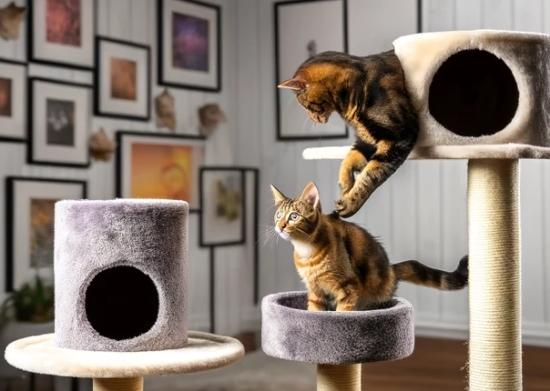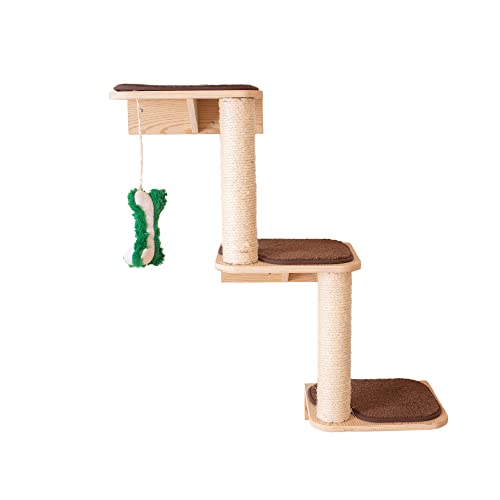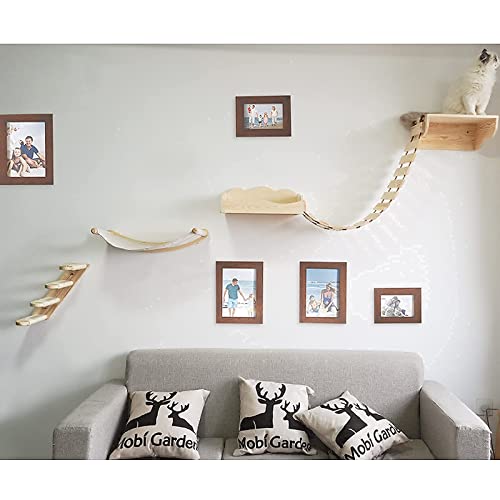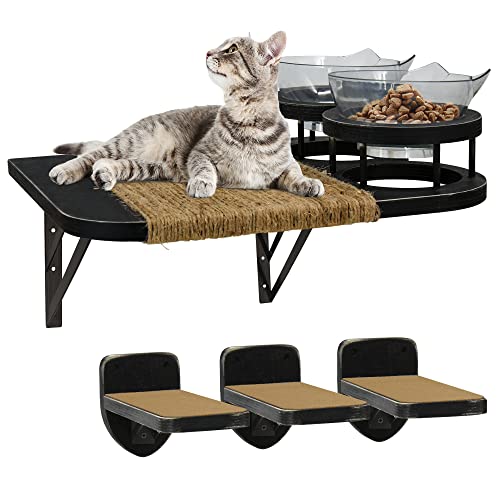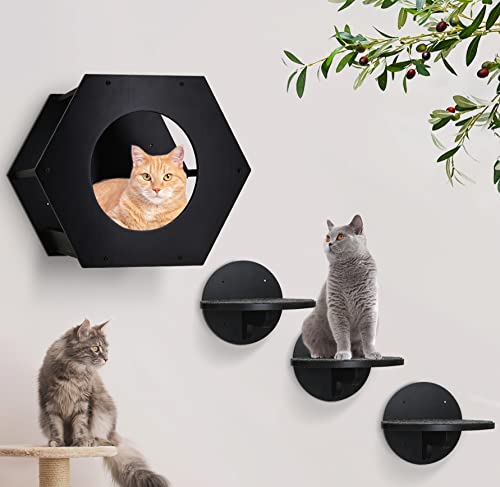The ubiquitous beige carpet-covered cat tree, a staple in many cat-loving homes, often stands as a testament to a common dilemma. It fulfills a feline need, providing a place to scratch, climb, and perch, yet it clashes horribly with the carefully curated décor of the living room. Or perhaps you've invested in a plush, expensive cat bed, only to find your discerning feline companion prefers the humble cardboard box it came in. The truth is, traditional cat furniture has often prioritized function over form, resulting in pieces that are either eyesores or simply don't resonate with a cat's innate instincts and preferences.
But times are changing. A new era of cat furniture has dawned, one that seamlessly blends style and function, creating pieces that are as aesthetically pleasing as they are enriching for our feline friends. This isn't just about superficial appearances; it's about a deeper understanding of what cats need and how their environment impacts their well-being. The latest trends in cat furniture demonstrate a growing understanding of feline needs and owner aesthetics, offering innovative designs that satisfy both cat and human. This is all about understanding cat behavior, new design trends and how to give your cat the best.
To truly appreciate the evolution of cat furniture, we must first delve into the feline psyche. What are the driving forces behind a cat's behavior? What do they really need from their environment? Cats are creatures of instinct, driven by deeply ingrained behaviors that have been honed over millennia of evolution. Scratching, for instance, isn't simply a destructive habit; it's a fundamental need. Cats scratch to mark their territory, leaving both visual and olfactory signals for other cats. They scratch to maintain their claws, shedding the outer layers to keep them sharp and healthy. And they scratch to stretch their muscles and tendons, a full-body workout that keeps them limber and agile.
Climbing is another innate feline behavior. In the wild, cats are both predator and prey, and height provides a significant advantage. A high vantage point allows them to survey their surroundings, spotting potential threats or prey from a safe distance. It also provides a sense of security and control over their environment. Think of a cat perched atop a bookshelf, observing the household activities with a regal air – that's the instinct at play.
Cats also have a strong need for secure, enclosed spaces. This stems from their natural denning behavior. In the wild, cats seek out sheltered spots to rest, raise their young, and escape from danger. A cozy cave, a hidden nook, or even a simple cardboard box provides a sense of safety and privacy, allowing them to relax and recharge. And of course, there is play. Play is essential for cats of all ages, providing physical exercise, mental stimulation, and an outlet for their hunting instincts. Interactive toys, scratching posts, and climbing structures can help keep cats engaged and prevent boredom. Finally, there is sleep. Cats will spend a big portion of their day resting, and it is important for them to have areas that they find comfortable.
A stimulating environment is crucial for a cat's overall well-being. When cats lack outlets for their natural behaviors, they can become stressed, bored, and even develop behavioral problems. A bored cat may resort to destructive scratching, excessive grooming, or even aggression. Providing enriching furniture and activities can significantly improve a cat's quality of life, reducing stress, promoting physical activity, and fostering a stronger bond with their human companions. Unfortunately, much of traditional cat furniture often falls short of meeting these needs. Many cat trees are unstable, prone to tipping over, which can be frightening for cats. The ubiquitous beige carpet, while offering a scratching surface, can be unattractive and difficult to clean. And many cat beds, while soft and plush, lack the enclosed, secure feeling that many cats crave.
Thankfully, a revolution is underway in the world of cat furniture design, often referred to as "catification." This movement, popularized by cat behaviorist Jackson Galaxy, emphasizes creating a home environment that caters to a cat's natural instincts and needs, while also being aesthetically pleasing for the human inhabitants. Catification is about understanding the "why" behind feline behavior and designing spaces that allow cats to express those behaviors in a positive and enriching way.
Several key design principles are driving the latest trends in cat furniture. Verticality is paramount. Providing cats with opportunities to climb and perch is essential for their sense of security and well-being. This can be achieved through tall cat trees, wall-mounted shelves, or even strategically placed furniture that allows cats to access higher spaces. Modularity is another important trend. Modular cat furniture systems allow you to customize and expand your cat's environment as needed. You can add shelves, scratching posts, and other components to create a truly personalized play and rest area.
Increasingly, cat furniture is being designed to integrate seamlessly with human furniture. This means no more hiding the cat tree in a corner! Modern cat furniture often resembles stylish pieces of home décor, blending in with the existing aesthetic rather than clashing with it. Sustainability is also a growing concern. Many manufacturers are now using eco-friendly materials, such as sustainably sourced wood, recycled cardboard, and natural fibers. And, of course, aesthetics are a major focus. Cat furniture is no longer an afterthought; it's becoming a design statement.
These principles are manifesting in a variety of exciting new products. Wall-mounted cat shelves and systems are gaining immense popularity. These can range from simple floating shelves that provide a perch, to elaborate modular systems that create entire cat walkways along the walls. They are a fantastic space-saving solution, particularly for smaller homes, and they add a visually interesting element to the room. Modern cat trees are moving away from the traditional carpet-covered behemoths. Instead, we're seeing sleek, sculptural designs that use wood, metal, and other contemporary materials. These trees often incorporate multiple levels, scratching posts, and enclosed spaces, providing a complete activity center for cats.
Designer cat beds are also evolving. There's a wide array of options available, from cozy caves and enclosed pods that provide a sense of security, to elevated platforms that allow cats to survey their surroundings. Materials range from soft, plush fabrics to natural fibers like cotton and wool. Hidden litter boxes are a game-changer for many cat owners. These clever designs conceal the litter box within a piece of furniture, such as a cabinet, a planter, or even a side table. This not only improves the aesthetics of the room but also helps to control odor and litter scatter. Interactive cat furniture is designed to keep cats engaged and entertained. This can include scratching posts with attached toys, puzzle feeders that challenge cats to work for their food, and even motorized toys that mimic the movement of prey.
The materials used in cat furniture play a crucial role in its functionality, durability, and aesthetic appeal. Natural materials are becoming increasingly popular, reflecting a growing awareness of sustainability and a desire for a more natural aesthetic. Wood is a versatile and durable choice, offering a warm and inviting look. Different types of wood, such as solid wood, plywood, and bamboo, offer varying levels of strength and aesthetic qualities. Solid wood is the most durable but also the most expensive. Plywood is a more affordable option, while bamboo is a rapidly renewable resource, making it an eco-friendly choice.
Sisal is a natural fiber derived from the agave plant and is widely considered the gold standard for scratching posts. Its rough texture is incredibly appealing to cats, providing the perfect surface for them to sharpen their claws and stretch their muscles. Sisal is also very durable, able to withstand years of scratching. Rattan and wicker, made from natural plant materials, offer a beautiful, bohemian aesthetic. However, they may not be as durable as sisal or wood, especially for enthusiastic scratchers. Cotton and wool are excellent choices for bedding and resting areas. They are soft, comfortable, and breathable, providing a cozy and inviting space for cats to nap.
Synthetic materials also have their place in cat furniture. Carpet, while often associated with traditional cat trees, can still be a good option for providing a soft and familiar scratching surface. However, it's important to choose a high-quality carpet that is durable and easy to clean, as it can harbor allergens and be difficult to remove fur from. Faux fur is another popular synthetic option, offering a luxurious and appealing texture for cats. It's generally easy to clean and can be a good alternative to real fur. Plastic and acrylic are often used in modern cat furniture designs, offering durability and a sleek, contemporary look. However, it's important to ensure that any plastic or acrylic used is non-toxic and free of harmful chemicals.
Choosing cat furniture made from sustainable and safe materials is not only good for the environment but also crucial for your cat's health. Look for furniture made from sustainably sourced wood, certified by organizations like the Forest Stewardship Council (FSC). Avoid furniture treated with harsh chemicals or finishes that could be harmful if ingested. Consider the entire lifecycle of the product, from its production to its eventual disposal.
Multi-functionality is a key trend in modern cat furniture, driven by a desire to maximize space and provide added value. Dual-purpose pieces are particularly appealing for those living in smaller homes or apartments, where every square foot counts. A cat tree that incorporates scratching posts, a bed, and even a play area provides multiple functions in a single unit. This not only saves space but also provides a more enriching environment for your cat. Cat shelves can double as bookshelves, providing storage for your books and other belongings while also giving your cat a place to climb and perch. This is a clever way to integrate cat furniture into your existing décor. Side tables with built-in cat beds or litter box enclosures are another excellent example of multi-functionality. They provide a functional surface for your living room while also discreetly accommodating your cat's needs. Coffee tables can even be designed with cat hammocks or play areas underneath, turning a typically unused space into a feline paradise. Window perches that attach to existing window sills offer a comfortable spot for your cat to bask in the sun and watch the world go by, without taking up valuable floor space.
For those with a creative streak, DIY cat furniture offers a rewarding and cost-effective alternative to store-bought options. The possibilities are endless, limited only by your imagination and DIY skills. Building your own cat furniture allows you to customize it to perfectly fit your space and your cat's specific needs. You can choose the materials, the design, and the features that will best suit your feline companion.
Simple wall-mounted shelves can be easily constructed using readily available materials like wood planks and brackets. These shelves can be arranged in a variety of configurations to create a customized climbing and perching area for your cat. Cardboard cat houses and play structures are a fun and eco-friendly option. You can upcycle cardboard boxes of various sizes to create elaborate castles, tunnels, and scratching surfaces. Sisal-wrapped scratching posts are a classic DIY project. You can use a sturdy piece of wood, such as a 4x4 post, and wrap it tightly with sisal rope, securing it with glue or staples. This provides a durable and satisfying scratching surface for your cat. Repurposed furniture offers a wealth of possibilities. An old dresser can be transformed into a multi-level cat condo, with drawers converted into beds and shelves added for climbing. An old suitcase can be lined with soft fabric to create a cozy cat bed.
When embarking on any DIY cat furniture project, safety should be your top priority. Ensure that any structures you build are stable and secure, able to withstand your cat's weight and activity. Avoid using any materials that could be toxic if ingested, such as certain types of paint, glue, or wood treatments. Sand down any rough edges or splinters to prevent injury.
Choosing the right cat furniture involves careful consideration of several factors. Start by assessing your cat's individual needs and preferences. Consider their age, size, activity level, and personality. A young, energetic kitten will have different needs than a senior cat with limited mobility. Observe your cat's current habits. Where do they like to sleep? Where do they scratch? Do they prefer enclosed spaces or open perches? This will give you clues about the types of furniture they will be most likely to use and enjoy.
Measure your space carefully before purchasing or building any cat furniture. Ensure that the furniture will fit comfortably in the designated area without obstructing traffic flow or creating a cluttered feel. Consider the height of the furniture, especially if you have low ceilings. Set a budget before you start shopping. Cat furniture prices can range from very affordable to quite expensive, depending on the materials, design, and brand. Determine how much you're willing to spend and stick to your budget.
Read reviews from other cat owners before making a purchase. Their experiences can provide valuable insights into the quality, durability, and cat-appeal of different products. Compare different brands and models to find the best value for your money. Finally, when introducing new furniture, do so gradually. Let your cat explore at their own pace. Don't force them to use it. Use positive reinforcement, such as treats, catnip, or praise, to encourage interaction. You can also try placing some of their favorite toys or bedding on the new furniture to make it more appealing.
The world of cat furniture is undergoing a remarkable transformation. It's no longer just about providing basic necessities; it's about creating a stylish, stimulating, and enriching environment for our feline companions. The key trends – sleek designs, multi-functional features, sustainable materials, and a focus on feline well-being – are all converging to create a new standard of excellence. The future of cat furniture is likely to see even more innovation, perhaps incorporating smart technology, such as interactive toys and automated feeding systems. We may also see even more personalized designs, tailored to the specific needs and preferences of individual cats. Investing in well-designed cat furniture is more than just a purchase; it's an investment in a happier, healthier, and more harmonious home for both cats and their owners. It's about recognizing that our feline companions deserve a space that is both beautiful and enriching, a space that reflects our love and appreciation for their unique personalities and needs. By embracing these new design ideas, we can truly create a space where both humans and their feline overlords can thrive.
